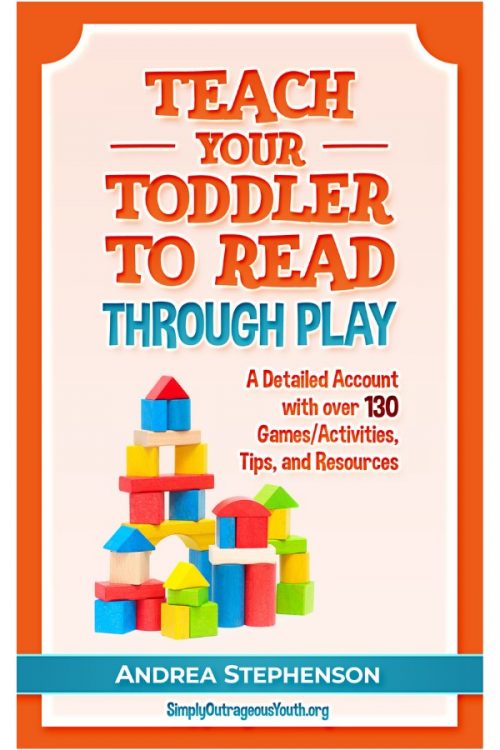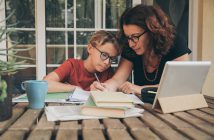Your three-year-old son can read on a third-grade level? How?
Just this past weekend, I saw my three-year-old son, Cory, reading a book to his Sunday School teacher and a group of kids. As soon as the teacher saw me, she said “This child can read at three-years-old? How did you do this?” When someone asks me this, my short answer is always by making reading fun, exposure to a variety of books, and playing with words.
Then later that day, I took my son to another child’s home for a birthday party. The kids were having so much fun playing inside and outside. At one point, Cory was playing with the Leapfrog letter set at the refrigerator and spelling words. He asked the birthday boy’s mother, who is a teacher, for the letter Tin order to spell the word gift. After spelling, the boy’s mom approached me and said “I can’t believe your son spelled gift!” I replied by saying “Yes, he loves to read and spell!” She said “How did you do this?” Again, I gave her my normal answer.
Is your son a genius?
Parents and teachers are usually amazed to know that my son was reading at 21 months. Right now, he can read on a third-grade level. They often say “He is a genius!” I think ALL CHILDREN ARE BORN GENUISES! Cory was born with the same capabilities as every other child. He was just exposed to words and language in a fun way at an early age. In my opinion, any child can do this!
Why did you teach your son to read so early?
It was not my intention to teach Cory to read as a toddler. I didn’t think he would learn the alphabet until the age of three or four. My objective was to expose him to words and language so he wouldn’t be a late communicator. In my experience as a social worker/play therapist, I noticed children who couldn’t speak would resort to hitting or kicking out of frustration. However, once they developed language this behavior would decrease because they could communicate their needs and wants.
As I started exposing Cory to words through play and reading, I noticed that he liked what I was doing. After reading a book to him as a baby, he would take the book and give it back to me. He wanted me to read it again. I remember my husband read the book, Brown Bear Brown Bear What Do You See ten times in a row to Cory at one time. He enjoyed the interactive activities and games we played, which I used to exposed him to new words daily. He has always loved playing with letters, learning the phonics, and blending sounds. Finally, there came a point where he had a desire to seek meaning from words through reading!
Watch my three-year-old son read the book, Charlotte’s Web. A book for children ages 8 and up.
Reading is boring.
Some kids think reading is boring. Many young children spend their days playing. Then once the child turns five or six-years-old, adults tell the child that they have to sit down, focus, and learn to read. Learning to read can be a frustrating process for some kids. It takes time and concentration because one of the best ways to become a better reader is to read. This can be difficult for the child who is a kinesthetic learner, as most kids are, and loves to be physical and experience what they are learning.
My Child is not trying hard enough
Sometimes when a child is behind on their appropriate reading level, the teacher will tell the parents. Parents usually get nervous and upset by this information, and these emotions transfer to the child. During home reading sessions, the parents get frustrated with the child because “they are not trying hard enough.” This most often leads kids to having a negative view of reading. They will often tell their parents “I hate reading!” In turn the parents become more upset because their child is behind their classmates and they are unable to motivate the child to read.
Parents don’t know where to start
Teaching a child to read can be an overwhelming task. First, you have to learn the alphabet, phonics, blending sounds, sight words, and the various rules of the English language. Parents may have a child that knows the alphabet and phonics but is having difficulty with teaching them sight words. Flashcards are often used to teach sight words, but again the child thinks this is SO BORING!
Furthermore, if a child is reading a book with a lot of words they are unfamiliar with, they may get irritated and want to do something else. Additionally, how do you explain that the word bat can be an animal and a tool used for baseball? Oh, and when you see the letters PH together, you should make the F sound. Also, C can make the short sound like in cat or the long sound like in cell.
My Child won’t sit during reading time.
I have heard many parents complain that their child doesn’t want to sit and read an entire book. As parents are reading, the child may look in space and not pay attention. Or if the child can read, they get distracted by something happening in the background. Sometimes a parent may read the first few pages of a book to a child but the story line is boring which causes their mind to wonder.
My Child is uninterested in reading about the topic.
A big reason why some kids don’t like to read is because they are uninterested in the topic. This often happens when kids have to read school textbooks or remember facts that they have no connection to. The kids are wondering why they have to know this information. Parents and teachers are trying to get their children to retain the information and it is just not happening for the child. This can be a pretty difficult situation to navigate.
Below are questions many parents have about reading…
What age should a child learn to read?
Most kids start learning to read at 6 or 7. Some kids start earlier at the age of 4 or 5. I believe children have the ability to recognize words earlier. My son started recognizing words at nine months.
One day my son and I were playing in the basement. I asked him to get the book, Brown Bear Brown Bear out of the bin. Out of the 12 books in the bin, he picked the correct title.
My son was able to blend sounds to make words at 21 months. The only reason he did this so early was because he was exposed to it as a baby. However, all children learn at different times and levels. They also learn with various methods. It is important to concentrate on your child’s level and their readiness to learn.
Watch the video below to see my son spelling at 21 months old
There are countless ways to teach kids to read. Kids learn through reading, talking with others, story-telling, workbooks, digital media and technology, learning phonics and sight words, blending sounds, writing, and asking questions.
I used playful in-depth learning to teach Cory to read. This included fun activities like singing, dancing, playing with blocks, magnetic tiles, Playdoh, drawing, games, role- play, writing stories with paint and sidewalk chalk, going outside to play and reading. It is important to read books that interest your child so they will gain the curiosity to seek meaning from words.
What if my child is not interested in a certain topic?
Children will be interested in reading when there is a connection to what they are learning. I remember in high school disliking my geography class because I felt no connection to other countries. My interest in geography did not come alive until I started to travel internationally while in college.
Let’s say you want your child to learn about other countries, then observe your child and see what they like and offer a connection. For the child who loves sports, have them read about Sports played in the countries. If your daughter loves princesses, have them read about princesses around the world.
How long should a child read each day?
Children should read at least 20 minutes a day. However, if a parent is doing formal reading lessons then all you need is 15 minutes a day. Outside of the 15 minutes, please know that reading can take place anywhere. Children can read a dinner menu, playground signs, grocery list, captions on their favorite cartoon.
How do I help my child who is struggling with reading?
First, you must define what struggling means. If you are comparing your child with other kids in the classroom or the national standards of reading and they are below their level, then yes, they may be struggling. However, if you don’t compare them to anyone, you may realize that they just need more time to get the concept.
When a child needs more time with reading, ensure you are teaching to their learning styles.
Auditory learners love to learn through hearing. Great activities for them would be to read books based on songs and retelling stories you have read and adding music with DIY instruments like banging the bottom of an oatmeal container. Visual learners use sight to learn. They would enjoy drawing and painting colorful stories and doing word puzzles and games with colorful pictures. Kinesthetic learners love to explore the world through touch and movement. Try building model sets based on books and doing a Treasure Word Hunt Game would be fun for them.
In my opinion, the best way for children to learn to read is through playful in-depth and natural wholesome interaction. It is the best way to create a desire in children to read.
This is why I have written the book, Teach Your Toddler to Read Through Play: A Detailed Account With Over 130 Games/Activities, Tips, and Resources.
My goal is to help you expose your child to words and reading in a fun way. This book will take you through a step by step process of how I taught my son to read. It gives you games/activities to do with your child along the way to make reading a process that is fun, natural, and interesting! It will help spark your child’s curiosity in wanting to seek meaning from words which is essentially reading.
This book provides the following…
- A detailed account of how I taught my son to read
- Over 130 Reading Games/Activities and Resources
- How to expose your child to new words through play
- The types of books to start your child’s reading journey
- How to encourage curiosity in your child
- Child brain development and how to develop faster connections in your baby’s brain
- How to expose newborn and babies to words through play and bonding
- How my son was able to recognize words as a baby
- How to make rereading books fun for you and your child
- Simple ways to create a literacy rich home
- The MOST important thing you can do as a parent to encourage reading in your household
- How songs and dancing assisted in teaching my son to read.
- How to take full advantage of the FREE Services at your Local library
- How Physical Activities can boost your child’s reading skills
- How to Teach the Alphabet in a Fun Way
- How to Teach the Phonics, Blending Sounds, and Sight Words in a Fun Way
- The three basic learning styles in children
- How to determine your child’s learning style
- How to expose children to new concepts aligned with their learning style
- How children with certain learning styles tend to communicate
- The toys/activities children with certain learning styles tend to favor
- How to make learning fun and playful for children
- How to determine the best time to teach your child
- How to execute Fun In-Depth Learning
- How to use the body’s senses to teach your child
- How to combine In-depth learning and learning styles during play
- How to incorporate digital media in your child’s learning
- How to teach a child with more than one learning style
- How to Structure your Day
- How to progress to teaching your child the phonics
- How Writing and Art can build a child’s reading skills
- How to Use Real World Experiences and Field Trips to expose children to language.
- How to Choose Books your Child will Like to Read.
- Strategies for When your Child Loses Interest in Reading.
- Examples of toys we used
- Examples of books we read through our journey
- Once your child begins to read, how to continue to build their skills.
Here is What Others are Saying About the Book
“This was a wonderfully detailed account of not only how to teach your child to read, but also how to connect with your child, support your child in a lifetime of loving to learn, and use your time caring for your child in a meaningful, fulfilling way. I am inspired as a mother, and I wish I’d known about this sooner!
I thought it was very well written, and the flow was perfect. The book flowed seamlessly from one chapter to the next, and I felt like it was organized perfectly.”
-Stacey
“This is a wonderful guidebook for parents who want to help their children begin learning at an early age through play. It is an introduction on how to nurture a love of learning and proficiency in reading in children, which in turn will open the door for your child to be exposed to and learn about a variety of topics. Andrea incorporates several learning styles in order to pave the way for a lifetime of learning.
I look forward to incorporating some of these techniques into playtime with my little learners.”
-Danielle J.
“This book documents the journey of an engaged parent who used creative and fun ways to introduce her son to books. This led to the child’s continuous interest in letters, words, sentences and naturally, reading. If you are willing to invest the time in incorporating the tips in this book with your child, he or she will also develop an interest in books and learn to read during the early stages of brain development. This book is an excellent example of the African Proverb “Each One Teach One.”
-Linsey Mills
This is a great e-book for parents with children ages 0-7! Invest in your child’s future. Reading is the most powerful tool to promote creativity, increase brain power, and it helps your child express themselves better! The best way to teach a child to spell and grammar rules is not through flashcards and worksheets but through reading and play!






Inspiring article. Spending time with our kids is the precious moment we can make. And seeing them learn is best. I have here a product that can help your child how to read. Here it is http://bit.ly/2YNyZ5M.
Want to know how I can get my child to understand reading he is in the 4th and is behind in reading
When your child starts bringing books home from school, have her read to you. If it doesn’t sound good (mistakes, choppy reading), have her read it again. Or read it to her, and then have her try to read it herself. Studies show that this kind of repeated oral reading makes students better readers, even when it is done at home.
http://bit.ly/2kkkYx